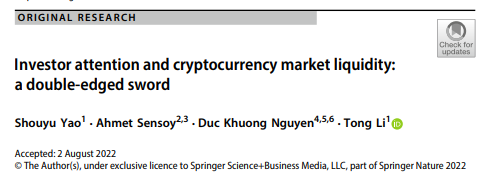
1 Introduction
Cryptocurrencies have grown popular in recent years, attracting many investors owing to their
decentralized structure, anonymity, and low transaction costs. As the number of cryptocurrencies
surges, cryptocurrency assets are gradually forming their own “ecosystem”, and the
dynamics of the cryptocurrency market has gained considerable attention from researchers
(Cong & He, 2019; Cong et al., 2021a, 2021b; Grobys & Junttila, 2021; Howell et al., 2020;
Liu & Tsyvinski, 2021; Makarov & Schoar, 2020; Sockin & Xiong, 2020).1 However, existing
studies have shown that cryptocurrencies are more regarded as emerging investment
assets (Baur et al., 2018; Blau, 2017; Celeste et al., 2020) rather than as a means of payment.
Liquidity, which reflects an asset’s ability to trade quickly, is crucial for investing in assets.
If cryptocurrency assets lack liquidity, it will increase the transaction cost of investors in the
market, make the market inefficient, and make the prices easier to be manipulated. As the
creation and transaction of cryptocurrencies are entirely supported by blockchain technology,
with no official agency to maintain and regulate, an intriguing question arises: will the liquidity
of cryptocurrencies be hurt when they suddenly receive a tremendous amount of investor
attention? Putting it differently, can the unique transaction mechanism of the cryptocurrency
market ensure the stability of its liquidity?
Traditional financial theories usually assume that investors can obtain all relevant information
and pay sufficient attention to assets in the process of analysis and reaction. Based
on this assumption, the efficient market hypothesis assumes that stock prices fully reflect all
relevant information (Fama, 1970). However, behavioral finance theory holds that attention
is a scarce cognitive resource due to the limited central cognitive processing capacity of the
human brain (Barber & Odean, 2008; Grossman & Stiglitz, 1980; Kahneman & Tversky,
1973). Attention is a necessary prerequisite for recognizing and acquiring information about
assets. When faced with numerous alternative assets, investors tend to prioritize assets with
more information and higher familiarity. A typical example is the local bias effect (Ackert
et al., 2005; Coval & Moskowitz, 1999; Huang et al., 2016; Seasholes & Zhu, 2010), i.e., the
tendency of investors to invest in stocks of local firms they know well. Thus, limited investor
attention easily influences investors’ decision-making behavior (Li & Yu, 2012; Mondria
et al., 2010; Peng, 2005; Peng & Xiong, 2006).
Recently, many studies have shown that investor attention has a significant impact on
the cryptocurrency markets, including returns (Dastgir et al., 2019; Liu & Tsyvinski, 2021;
Philippas et al., 2019; Subramaniam & Chakraborty, 2020; Zhang & Wang, 2020), price discovery
(Ibikunle et al., 2020), and volatility (Sabah, 2020; Yao et al., 2021a; Zhang & Wang,
2020). However, little research has focused on the relationship between investor attention and
cryptocurrency market liquidity as well as the role of investor attention in different market
states. This paper bridges this gap by dividing investor attention into static and abnormal
investor attention and exploring the induced impacts on cryptocurrency market liquidity.
Our study extends the literature examining the impact of investor attention on asset liquidity.
Merton (1987) proposes the concept of investor cognition and shows that investor
attention is related to stock pricing and liquidity. In the traditional stock markets, relevant
studies indicate that investor attention can enable investors to obtain more effective information,
alleviate the problem of information asymmetry, increase investors’ trading activity,
and thus improve stock liquidity (Aouadi et al., 2013; Bank et al., 2011; Ding & Hou, 2015;
Grullon et al., 2004). Specifically, Grullon et al. (2004) employ the firms’ advertising expenditure
to study the influence of investor attention on stock liquidity. They find that advertising
expenditure has a significant positive relationship with the number of investors and stock liquidity.
Bank et al. (2011) use the Google search index to measure investor attention and
explore the impact of investor attention on stock market liquidity. They find that the increase
in Google search leads to an increase in stock trading activities and liquidity, mainly due
to the reduction of information asymmetry. In addition, Ding and Hou (2015) indicate that
investor attention is a necessary condition for a firm to be recognized. Moreover, investors’
attention expands the firm’s reputation and significantly improves the stock liquidity. The
above research suggests that investors’ attention can arouse the interest of potential investors
who can collect relevant information to reduce information asymmetry, thus driving them to
participate in trading and improve stock liquidity. Due to a large number of cryptocurrencies
and the imperfect information transparency, a sustained high level of attention for a particular
cryptocurrency over a certain period can attract more investors and lead to more frequent buy
and sell activities. Therefore, we expect that static investor attention can enhance the willingness
to buy and sell at the same time and thereby improve the liquidity of the cryptocurrency
markets.
Previous studies often employ abnormal attention as an alternative proxy of investor
attention in the robustness tests (Da et al., 2011; Ding & Hou, 2015; Drake et al., 2012).
A consensus is that abnormal attention significantly improves stock liquidity (Adachi et al.,
2017; Takeda & Wakao, 2014). However, Cheng et al. (2021a) document that the impact
of retail investors’ abnormal attention on stock liquidity improvement gradually weakens
and even reverses in the long run. For stocks that generate an unusual increase in investor
attention, investors buy far more than sell, resulting in mismatched orders and reducing the
asset liquidity.
Cryptocurrency markets provide an ideal environment for our study on the double-sided
nature of investor attention, due to their specific characteristics such as a larger proportion of
retail investors than the stock market,2 the absence of links to explicit economic fundamentals
(Koutmos, 2018; Nadarajah & Chu, 2017), and the speculative trading (Baur et al., 2018;
Cheah & Fry, 2015; Corbet et al., 2018; Fry & Cheah, 2016). Moreover, since their trading
mechanism is mainly order-driven, the liquidity supply is endogenous and mainly provided
by the traders through the submission of orders. Under extreme conditions, investors have no
obligation to provide liquidity to keep the market running smoothly. The uniqueness of the
cryptocurrency markets’ trading mechanism thus makes them more vulnerable to the impact
of external events.
The liquidity in the cryptocurrency markets may also worsen due to the crowding effect
following an unusual increase in investor attention. On the one hand, the latter drives up
investors’ net buying behavior because the increased attention helps solve the search problem
they face when choosing assets to buy (Barber & Odean, 2008). When a large number of
investors gather in the buying direction, the market will become “crowded”, and it will be
more difficult for the buyer to match the right seller, resulting in increased transaction costs
and reduced liquidity. On the other hand, reduced trading frictions can further exacerbate the
crowding effect and liquidity deterioration (Afonso, 2011). The increased abnormal attention




